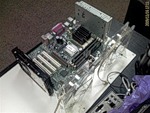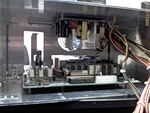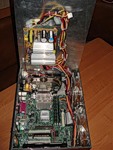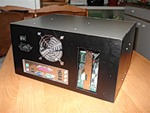Old NAS rubbish not to surprise
Every day, watching a pile of old and already useless iron, I decided to build NAS from spare parts (well, what else?). It was decided to do the case yourself, because:
1) I wanted something unusual
2) I wanted to work with my hands
3) and this is interesting in the end!
First, the choice fell on the old Cel433 and some kind of nameless mat. the board, which was subsequently replaced by the branded Steudovskaya one, and Cel433 on the Cel600 - although the performance of the first was quite enough. Estimate the final layout

Initially, I wanted to make the NAS quiet, so I decided to use large (80-120 mm) and low-speed coolers for flow ventilation of the case, and remove all other fans. At first I thought of placing two 80 mm in front of them, followed by a power supply unit (without casing), and behind it already mat. the board, but the length of the case turned out to be too big, because I used two 120 mm coolers (800 rpm) and the layout as in the photo - the power supply unit "hangs" over the mat. board: The case is made of aluminum composite "Alucobond" - 3 mm plastic sheet with the outer layers of aluminum alloy. The material is very well processed, strong enough and not heavy. Sheets were fastened to each other at first at the corners, and then the joints were filled with epoxy glue:


Because on the mat. there is no SATA board; I had to buy a controller, but downloading is still possible only from IDE devices, so I had to use an old hard drive, which in the future is planned to be replaced with a CF card with an adapter. The main sources of noise - hard drives - are attached to the sides of the case and the “product” takes on a finished look: In addition to the top cover, the case was painted with matte acrylic paint and a bit unsuccessful - the paint does not hold very well on the panel coating, but overall I was satisfied:





Another entertainment was the installation of Gentoo with a full-complete sorting and fitting of all the software, of course, including the kernel and throwing out all that was unnecessary. An SMB server, transmission will work on the NAS, and due to the presence of a sound card, it will be some kind of player that can be used from other home computers and other devices. Perhaps I’ll also think about UPnP / DAAP. He also piled lighttpd with django, on which he began to write a web-interface: Here is such a “second life” of old iron, whose performance for certain tasks was quite and even more than enough. The article is published about the request of my friend who wants to get to Habr. If the article gets enough votes, then an invitation will be sent to him. In the meantime, you can ask questions and I will respond on behalf of the author of the article. UPD:

Thank habrocheloveu spanasik for providing an invite. The author of the article is helions8 . Direct all profits to him.
1) I wanted something unusual
2) I wanted to work with my hands
3) and this is interesting in the end!
First, the choice fell on the old Cel433 and some kind of nameless mat. the board, which was subsequently replaced by the branded Steudovskaya one, and Cel433 on the Cel600 - although the performance of the first was quite enough. Estimate the final layout

Initially, I wanted to make the NAS quiet, so I decided to use large (80-120 mm) and low-speed coolers for flow ventilation of the case, and remove all other fans. At first I thought of placing two 80 mm in front of them, followed by a power supply unit (without casing), and behind it already mat. the board, but the length of the case turned out to be too big, because I used two 120 mm coolers (800 rpm) and the layout as in the photo - the power supply unit "hangs" over the mat. board: The case is made of aluminum composite "Alucobond" - 3 mm plastic sheet with the outer layers of aluminum alloy. The material is very well processed, strong enough and not heavy. Sheets were fastened to each other at first at the corners, and then the joints were filled with epoxy glue:


Because on the mat. there is no SATA board; I had to buy a controller, but downloading is still possible only from IDE devices, so I had to use an old hard drive, which in the future is planned to be replaced with a CF card with an adapter. The main sources of noise - hard drives - are attached to the sides of the case and the “product” takes on a finished look: In addition to the top cover, the case was painted with matte acrylic paint and a bit unsuccessful - the paint does not hold very well on the panel coating, but overall I was satisfied:





Another entertainment was the installation of Gentoo with a full-complete sorting and fitting of all the software, of course, including the kernel and throwing out all that was unnecessary. An SMB server, transmission will work on the NAS, and due to the presence of a sound card, it will be some kind of player that can be used from other home computers and other devices. Perhaps I’ll also think about UPnP / DAAP. He also piled lighttpd with django, on which he began to write a web-interface: Here is such a “second life” of old iron, whose performance for certain tasks was quite and even more than enough. The article is published about the request of my friend who wants to get to Habr. If the article gets enough votes, then an invitation will be sent to him. In the meantime, you can ask questions and I will respond on behalf of the author of the article. UPD:

Thank habrocheloveu spanasik for providing an invite. The author of the article is helions8 . Direct all profits to him.
